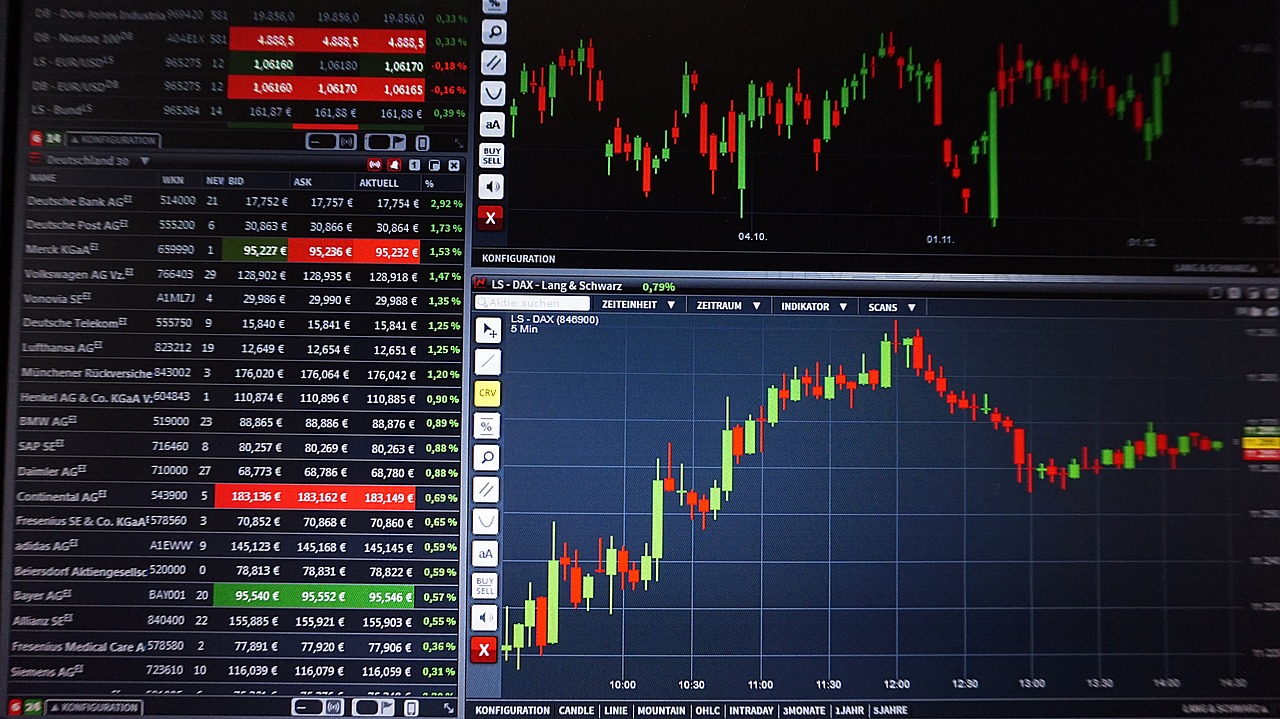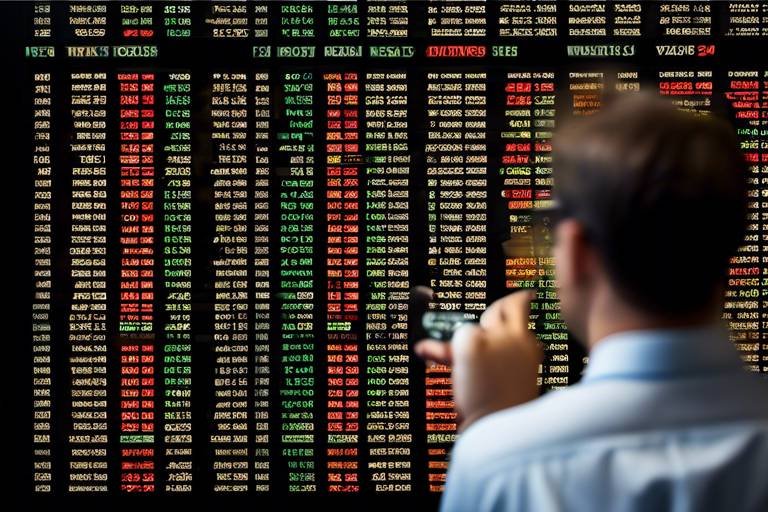Market Analysis - How to Identify Crypto Opportunities
In the ever-evolving world of cryptocurrency, staying ahead of the curve is essential for any investor looking to capitalize on potential gains. The crypto market is often compared to a rollercoaster ride—full of ups and downs, twists and turns that can leave even seasoned traders feeling dizzy. So, how do you navigate this thrilling landscape and identify those hidden gems waiting to explode? Well, buckle up, because in this article, we’re diving deep into the strategies and tools that can help you spot lucrative opportunities in the crypto market.
Analyzing market trends is crucial for identifying potential investment opportunities. Think of market trends as the weather forecast for your investment journey. Just like a sunny day can lead to a picnic, a bullish market can mean profits for savvy investors. Conversely, a bearish trend can feel like a sudden downpour, leaving you drenched if you're not prepared. Recognizing these trends involves looking at price movements over time and understanding the underlying factors that drive them.
To spot a bullish trend, look for consistent higher highs and higher lows on a price chart. This indicates that buyers are in control and pushing prices up. On the other hand, a bearish trend is characterized by lower highs and lower lows, suggesting that sellers are dominating the market. By keeping an eye on these patterns, you can position yourself to take advantage of potential price movements.
Now that you have a grasp of market trends, let’s delve into the exciting world of technical analysis. This involves evaluating price charts and indicators to predict future price movements—think of it as reading the stars to forecast the weather. The fundamental concepts of technical analysis can provide you with a roadmap for your trading decisions.
Chart patterns are visual representations of market behavior that can reveal a lot about future price movements. For instance, the "head and shoulders" pattern is often seen as a signal of a trend reversal. Imagine it like a mountain range—when the peaks start to form a specific shape, it can indicate that the market is about to change direction. Understanding these patterns can give you a significant edge in your trading strategy.
Support and resistance levels are critical in determining price entry and exit points. Support levels act like a safety net, indicating where the price tends to bounce back up, while resistance levels signify where the price struggles to rise further. Identifying these levels can be likened to finding the perfect spot to set up a tent during a camping trip—too close to the edge, and you risk a fall, but finding the right balance can lead to a cozy night under the stars.
Indicators and oscillators provide additional insights into market conditions, much like a compass guides a traveler. Popular tools like the Relative Strength Index (RSI) and Moving Average Convergence Divergence (MACD) can help you make informed trading decisions. The RSI, for example, can indicate whether a cryptocurrency is overbought or oversold, while the MACD can signal potential buy or sell opportunities based on moving averages.
Market sentiment analysis helps gauge the overall mood of investors. It’s like tuning into the vibes of a party—are people excited and dancing, or are they sitting quietly in a corner? By utilizing sentiment indicators and monitoring social media trends, you can identify potential opportunities before they become mainstream. Understanding how the crowd feels can often lead you to the next big investment.
While technical analysis focuses on price movements, fundamental analysis digs deeper into the intrinsic value of cryptocurrencies. This involves looking at key factors that influence crypto prices, such as the technology behind the coin, the team driving the project, and overall market demand. Just like evaluating a restaurant before dining, you want to ensure that the project you’re investing in has solid foundations.
Evaluating cryptocurrency projects involves assessing their whitepapers, use cases, and development teams. A well-crafted whitepaper is like a blueprint for a house—it outlines the vision and practicality of the project. When assessing a project, consider the following:
- Whitepaper Quality: Does it clearly explain the technology and purpose?
- Use Cases: Is there a real-world application for the cryptocurrency?
- Development Team: Are the team members experienced and reputable?
By conducting thorough evaluations, you can make more informed investment choices and avoid potential pitfalls.
Regulatory developments can significantly impact the crypto market. Staying informed about regulations is crucial, as they can create both opportunities and challenges. Think of regulations as the rules of the game—understanding them can help you play smarter and avoid costly mistakes. Regularly check reputable news sources and follow industry experts to stay updated on any changes that could affect your investments.
Q: How can I start analyzing the cryptocurrency market?
A: Begin by familiarizing yourself with market trends, technical analysis, and fundamental analysis. Utilize online resources, courses, and tools to enhance your understanding.
Q: What are the best tools for technical analysis?
A: Popular tools include TradingView for charting, CoinMarketCap for market data, and various indicators like RSI and MACD available on most trading platforms.
Q: How important is market sentiment?
A: Market sentiment is crucial as it can drive price movements. Understanding investor psychology can help you anticipate market shifts.
Q: Should I focus on technical or fundamental analysis?
A: Both analyses are important. Technical analysis helps you time your trades, while fundamental analysis ensures you’re investing in projects with solid potential.

Understanding Market Trends
In the ever-evolving world of cryptocurrency, is essential for anyone looking to invest wisely. Just like a surfer riding a wave, you want to catch the right trend at the right time. Failing to recognize whether the market is bullish or bearish can mean the difference between making a profit and incurring losses. So, how can you identify these trends effectively?
Market trends are generally categorized into three types: uptrends, downtrends, and sideways trends. An uptrend is characterized by a series of higher highs and higher lows, indicating that the market is moving upwards. Conversely, a downtrend features lower lows and lower highs, signaling a downward movement. Sideways trends occur when the market lacks a clear direction, fluctuating within a specific range. Understanding these trends can help you make informed decisions about when to buy or sell.
To identify these trends, you can utilize various tools and techniques. One effective method is to analyze price charts. By observing past price movements, you can spot patterns that might indicate future behaviors. Additionally, employing moving averages can smooth out price data, making it easier to see the overall direction of the market. For instance, if the price consistently stays above a particular moving average, it may suggest a bullish trend.
Another critical aspect of trend analysis is recognizing the significance of volume. Volume refers to the number of coins traded during a specific period. A rising trend accompanied by increasing volume often reinforces the strength of that trend. Conversely, if prices are rising but volume is declining, it may signal that the trend is losing momentum. Thus, volume can serve as a vital confirmation tool for your analysis.
Moreover, it's essential to keep an eye on external factors that can influence market trends. Economic indicators, regulatory news, and technological advancements can all play a significant role in shaping the market landscape. For example, a new regulation that favors cryptocurrency adoption can lead to a bullish trend, while negative news can trigger panic selling and a bearish trend.
In summary, understanding market trends is a multifaceted process that requires a combination of technical analysis, volume observation, and awareness of external influences. By honing your skills in recognizing these trends, you can position yourself to seize lucrative opportunities in the cryptocurrency market. Remember, the key is to stay informed and be adaptable, as the market can change in the blink of an eye.

Technical Analysis Basics
When diving into the world of cryptocurrency trading, understanding technical analysis is like learning the secret handshake of an exclusive club. It’s not just about looking at numbers and charts; it’s about interpreting the story they tell. Technical analysis involves evaluating price charts and various indicators to predict future price movements, helping traders make informed decisions. Imagine trying to navigate a maze without a map—technical analysis is that map, guiding you through the twists and turns of the crypto market.
At its core, technical analysis is based on the belief that historical price movements can provide insights into future behavior. Traders use this approach to identify patterns and trends that may signal potential buying or selling opportunities. But how do you get started? First, you need to familiarize yourself with some fundamental concepts and tools that are essential in the world of crypto trading.
Chart patterns are the visual representations of market behavior, and they can be incredibly revealing. Think of them as the fingerprints of market sentiment. Common patterns include the head and shoulders, triangles, and flags. Each pattern has its own significance and can indicate potential market reversals or continuations. For example, a head and shoulders pattern often suggests that a bullish trend is about to reverse, while a triangle pattern can indicate a period of consolidation before a breakout.
Understanding these patterns can significantly enhance your trading strategy. Here’s a quick overview of some common chart patterns:
| Pattern | Indication |
|---|---|
| Head and Shoulders | Bearish reversal pattern |
| Inverse Head and Shoulders | Bullish reversal pattern |
| Triangles | Continuation or reversal depending on breakout direction |
| Flags | Continuation pattern |
Next up are support and resistance levels, which are critical for determining where to enter and exit trades. Support is the price level at which a downtrend can be expected to pause due to a concentration of demand, while resistance is where an uptrend may stall due to a concentration of selling. Think of support as a safety net and resistance as a ceiling. Identifying these levels can help you make strategic decisions about when to buy or sell.
To identify support and resistance levels, traders often look for historical price points where the price has repeatedly bounced off or struggled to break through. This can be done using horizontal lines on a chart or more complex methods like Fibonacci retracement levels.
Indicators and oscillators provide additional insights into market conditions. They are like the tools in a mechanic's toolbox—each serves a different purpose. Two popular tools among traders are the Relative Strength Index (RSI) and the Moving Average Convergence Divergence (MACD). The RSI measures the speed and change of price movements and can indicate whether a cryptocurrency is overbought or oversold. Meanwhile, the MACD helps traders identify momentum and trends by showing the relationship between two moving averages of a security’s price.
By combining these tools with your knowledge of chart patterns and support/resistance levels, you create a robust trading strategy. Remember, technical analysis isn’t foolproof, but it can significantly increase your chances of making informed decisions in the dynamic world of cryptocurrency trading.
- What is technical analysis? Technical analysis is a method used to evaluate and predict the future price movements of cryptocurrencies by analyzing historical price data and market trends.
- Why is understanding chart patterns important? Chart patterns help traders identify potential market reversals or continuations, allowing for more informed trading decisions.
- How can support and resistance levels impact trading decisions? Support and resistance levels indicate where prices may reverse or consolidate, helping traders determine optimal entry and exit points.
- What are some common indicators used in technical analysis? Popular indicators include the Relative Strength Index (RSI) and Moving Average Convergence Divergence (MACD), which help assess market momentum and conditions.

Chart Patterns
Chart patterns are like the fingerprints of the market; they reveal the underlying behavior and sentiment of traders. Recognizing these patterns can be a game-changer for anyone looking to navigate the often tumultuous waters of cryptocurrency trading. When you look at a price chart, you're not just seeing numbers; you're witnessing a story unfold. Each rise and fall tells us something about market psychology, and understanding these patterns can help you anticipate future movements.
One of the most common patterns you'll encounter is the Head and Shoulders. This pattern typically signals a reversal in trend. Imagine a mountain peak: the first rise is the left shoulder, the peak is the head, and the second rise is the right shoulder. When you see this formation, it’s often a sign that the price may be about to drop. Conversely, the Inverse Head and Shoulders is a bullish pattern that suggests a potential upward reversal. It's like a phoenix rising from the ashes, indicating that the market is ready to take off.
Another significant pattern is the Double Top and Double Bottom. These patterns indicate potential reversals as well. The Double Top looks like an M shape, signaling that the price is likely to decline after hitting resistance twice. On the other hand, the Double Bottom resembles a W, suggesting that the price may rise after hitting support twice. Understanding these patterns is crucial for making informed trading decisions.
To help you visualize these patterns, here’s a simple table that outlines some common chart patterns and their implications:
| Chart Pattern | Type | Implication |
|---|---|---|
| Head and Shoulders | Bearish | Potential trend reversal from bullish to bearish |
| Inverse Head and Shoulders | Bulllish | Potential trend reversal from bearish to bullish |
| Double Top | Bearish | Potential price decline after hitting resistance |
| Double Bottom | Bulllish | Potential price increase after hitting support |
Moreover, there are other patterns like Flags and Pennants, which are continuation patterns. They signal that the price is likely to continue in the same direction after a brief pause. Think of them as a runner taking a quick breather before sprinting towards the finish line. Recognizing these patterns can give you an edge in timing your entries and exits.
In conclusion, mastering chart patterns is a vital skill for any crypto trader. The market is constantly evolving, and being able to read these patterns can help you stay ahead of the curve. So, the next time you look at a price chart, remember that it's not just about numbers; it's about understanding the emotions and behaviors driving those numbers. By honing your skills in pattern recognition, you'll be better equipped to identify opportunities and make informed trading decisions.
Q: How do I start recognizing chart patterns?
A: Begin by studying historical price charts and focusing on identifying the patterns discussed. Practice makes perfect!
Q: Are chart patterns reliable indicators of future price movements?
A: While they can provide insights, no indicator is foolproof. It's best to combine chart patterns with other analysis techniques.
Q: Can I use chart patterns for all cryptocurrencies?
A: Yes, chart patterns can be applied across various cryptocurrencies, but always consider the unique market conditions of each asset.

Support and Resistance Levels
Support and resistance levels are fundamental concepts in technical analysis that every crypto trader should grasp. They act as psychological barriers in the market, influencing the behavior of traders and investors alike. In simple terms, support refers to a price level where a downtrend can be expected to pause due to a concentration of demand. Conversely, resistance is a price level where an uptrend can pause due to a concentration of supply. Understanding these levels can significantly enhance your trading strategy and decision-making process.
Imagine you're trying to push a heavy object uphill. As you push, you find certain points where the object resists your effort, and you have to exert more force to continue. In the world of crypto, these points are akin to resistance levels. On the flip side, when the object rolls downhill, there are points where it slows down due to friction—these are similar to support levels. Recognizing these dynamics can help you determine when to enter or exit a trade.
Identifying support and resistance levels can be done through various methods, including:
- Historical Price Levels: Look at past price movements to see where the price has previously reversed. These levels often act as future support or resistance.
- Moving Averages: Traders frequently use moving averages, such as the 50-day or 200-day moving average, as dynamic support and resistance levels.
- Fibonacci Retracement Levels: This tool helps identify potential reversal levels based on the Fibonacci sequence, providing a mathematical approach to support and resistance.
To illustrate this further, let's take a look at a simple table that outlines how to recognize these levels:
| Type | Characteristics | Impact on Trading |
|---|---|---|
| Support | Price level where buying interest is strong | Potential buying opportunity |
| Resistance | Price level where selling interest is strong | Potential selling opportunity |
As you analyze the charts, keep an eye out for these levels. They can often be identified with the help of various indicators. For instance, when the price approaches a support level, traders may look for signs of a reversal, such as bullish candlestick patterns or increased buying volume. On the other hand, if the price nears a resistance level, it might be a good time to consider taking profits or placing a sell order.
In conclusion, mastering the identification of support and resistance levels is crucial for any trader wanting to navigate the volatile waters of the cryptocurrency market. By understanding these concepts, you can make more informed decisions that align with market movements and enhance your overall trading strategy.
Q1: How can I effectively identify support and resistance levels?
A1: You can identify them by analyzing historical price data, using moving averages, and applying tools like Fibonacci retracement levels. Look for areas where the price has reversed in the past.
Q2: Do support and resistance levels change over time?
A2: Yes, they can change as new price data emerges. A former resistance level can become a support level if the price breaks above it and vice versa.
Q3: How do I know if a support or resistance level will hold?
A3: While there's no surefire way to predict this, watching for increased trading volume and bullish or bearish patterns can provide clues about the strength of these levels.

Indicators and Oscillators
When diving into the world of cryptocurrency trading, understanding indicators and oscillators is like having a compass in a dense forest. They guide you through the tumultuous market, helping you make informed decisions. These tools are essential for traders looking to predict future price movements based on past behavior. But what exactly are they, and how can they help you spot the next big opportunity?
Indicators are mathematical calculations based on the price, volume, or open interest of a security or contract. They help traders identify market trends and potential reversals. On the other hand, oscillators are a type of indicator that moves between a fixed range, usually from 0 to 100. They help traders determine whether a market is overbought or oversold. This distinction is vital, as it can prevent costly mistakes and enhance your trading strategy.
Two of the most popular indicators among crypto traders are the Relative Strength Index (RSI) and the Moving Average Convergence Divergence (MACD). Let’s break them down:
| Indicator | Description | Use Case |
|---|---|---|
| Relative Strength Index (RSI) | A momentum oscillator that measures the speed and change of price movements. | Identifying overbought or oversold conditions in a market. |
| Moving Average Convergence Divergence (MACD) | A trend-following momentum indicator that shows the relationship between two moving averages of a security's price. | Spotting potential buy or sell signals through crossovers. |
The RSI is particularly useful because it provides a clear visual representation of market conditions. A reading above 70 typically indicates that a cryptocurrency is overbought, suggesting a potential price drop. Conversely, a reading below 30 indicates that it may be oversold, hinting at a possible price increase. This can be a game-changer for traders looking to time their entries and exits effectively.
Meanwhile, the MACD is favored for its ability to identify momentum shifts. When the MACD line crosses above the signal line, it’s often seen as a bullish signal, while a crossover below can indicate bearish sentiment. This dual functionality makes it a powerful tool for traders looking to capture trends early.
However, relying solely on these indicators can be risky. It’s essential to combine them with other analysis methods, such as fundamental analysis and market sentiment analysis, to create a comprehensive trading strategy. Think of indicators and oscillators as part of a larger toolkit; they provide insights, but they don’t tell the whole story.
In summary, mastering indicators and oscillators can significantly enhance your trading prowess in the cryptocurrency market. By understanding how to interpret these tools, you can better navigate the complexities of price movements and make more informed investment decisions. So, the next time you’re analyzing a chart, remember: these indicators are your allies in the quest for crypto opportunities!
Frequently Asked Questions
- What is the best indicator for crypto trading? The best indicator depends on your trading style. Many traders find the RSI and MACD to be effective, but it's crucial to combine them with other analyses.
- How often should I check my indicators? It varies based on your trading strategy. Day traders might check indicators multiple times a day, while long-term investors may review them weekly or monthly.
- Can indicators guarantee profits? No, indicators are tools to aid decision-making. They can improve your chances but cannot guarantee profits.

Market Sentiment Analysis
This article explores various strategies and tools for identifying lucrative opportunities in the cryptocurrency market, providing insights into market trends, analysis techniques, and investment strategies.
Analyzing market trends is crucial for identifying potential investment opportunities. This section discusses how to recognize bullish and bearish trends and their implications for crypto investments.
Technical analysis involves evaluating price charts and indicators to predict future price movements. Here, we cover the fundamental concepts and tools used in technical analysis for crypto trading.
Chart patterns are visual representations of market behavior. This part explains common chart patterns, such as head and shoulders, and their significance in predicting price movements.
Support and resistance levels are critical in determining price entry and exit points. This section explores how to identify these levels effectively.
Indicators and oscillators provide additional insights into market conditions. Here, we examine popular tools like RSI and MACD and their roles in making informed trading decisions.
Market sentiment analysis is a fascinating aspect of trading that dives deep into the collective feelings of investors towards cryptocurrencies. It’s like tuning into the heartbeat of the market; by understanding whether the mood is optimistic or pessimistic, you can make more informed trading decisions. But how do you gauge this sentiment? Well, there are several methods and tools at your disposal.
One effective way to assess market sentiment is by utilizing sentiment indicators. These indicators analyze data from various sources, including social media platforms, news articles, and forums, to provide a snapshot of how investors feel about a particular cryptocurrency. For example, if a cryptocurrency is trending positively on Twitter, it might indicate a bullish sentiment, suggesting that it could be a good time to invest.
Another key component of sentiment analysis is observing the volume of discussions around specific coins. If you notice a surge in conversations about a particular cryptocurrency, it could signal an upcoming price movement. Additionally, platforms like Reddit and Telegram can offer valuable insights into community sentiment. Engaging in these communities can provide a personal touch to your analysis, as you can gauge the excitement or fear surrounding certain projects.
Moreover, it’s essential to watch out for fear and greed indexes. These indexes compile various data points to measure the prevailing emotions in the market. A high greed level might suggest that the market is due for a correction, while extreme fear could indicate a potential buying opportunity. Understanding these emotional triggers can be the difference between making a profit and incurring losses.
In summary, market sentiment analysis is not just about numbers and charts; it’s about understanding the psychology of investors. By combining sentiment indicators, social media trends, and community engagement, you can uncover potential opportunities that others might overlook. So, the next time you’re analyzing a cryptocurrency, don’t forget to check the mood of the market!
Fundamental analysis focuses on the intrinsic value of cryptocurrencies. This part covers key factors influencing crypto prices, including technology, team, and market demand.
Evaluating cryptocurrency projects involves assessing their whitepapers, use cases, and development teams. This section provides a framework for conducting thorough project evaluations.
Regulatory developments can significantly impact the crypto market. Here, we discuss how to stay informed about regulations and their potential effects on investment opportunities.
- What is market sentiment analysis? Market sentiment analysis is the process of gauging the collective feelings of investors towards a cryptocurrency, often using indicators and social media trends.
- Why is market sentiment important? Understanding market sentiment can help traders make informed decisions, as it reveals the emotional state of the market which can influence price movements.
- How can I measure market sentiment? You can measure market sentiment using sentiment indicators, monitoring social media conversations, and analyzing fear and greed indexes.

Fundamental Analysis in Crypto
When it comes to investing in cryptocurrencies, understanding fundamental analysis is like having a compass in uncharted waters. It helps you navigate through the complexities of the market by focusing on the intrinsic value of a cryptocurrency rather than just the price fluctuations. So, what exactly does this entail? Fundamental analysis looks at various factors that can influence the price of a cryptocurrency, such as its underlying technology, the team behind the project, and the overall market demand.
First and foremost, let's talk about the technology. Each cryptocurrency has its own unique technology and use case. For instance, Bitcoin is primarily a digital currency, while Ethereum serves as a platform for decentralized applications. When evaluating a cryptocurrency, ask yourself: Does the technology solve a real-world problem? Is it scalable? Understanding these aspects can provide a clearer picture of a coin's potential longevity and success.
Next up is the team behind the cryptocurrency. A strong team can be the backbone of any successful project. Look for developers and advisors with a proven track record in the tech or finance sectors. Do they have credible experience? Have they previously worked on successful projects? A solid team can be a good indicator that the project is in capable hands. You can often find this information in the project's whitepaper or on their official website.
Another important factor is market demand. This is where things can get a bit tricky. Demand can be influenced by various elements, including market trends, community support, and even social media buzz. For example, if a cryptocurrency is gaining traction on platforms like Twitter or Reddit, this can signal increased interest and potential price appreciation. Keeping an eye on these trends can help you identify which projects are worth your investment.
To illustrate these factors, consider the following
| Factor | Importance | Key Questions |
|---|---|---|
| Technology | High | Does it solve a real-world problem? Is it scalable? |
| Team | High | What is their track record? Have they succeeded before? |
| Market Demand | Medium | Is it trending on social media? What is the community sentiment? |
Now, let's not forget about the regulatory considerations. The crypto landscape is constantly evolving, and regulations can significantly impact prices and project viability. It's crucial to stay informed about any regulatory changes that could affect your investments. For instance, news about a country banning or embracing cryptocurrency can cause a ripple effect across the market. So, keeping your ear to the ground can save you from unexpected losses.
In summary, conducting a thorough fundamental analysis is essential for anyone looking to make informed decisions in the crypto space. By evaluating the technology, team, market demand, and regulatory environment, you can better position yourself to identify lucrative investment opportunities. Remember, in the world of cryptocurrency, knowledge is power, and understanding the fundamentals can lead you to the treasure hidden beneath the surface.
- What is fundamental analysis in cryptocurrency? Fundamental analysis involves evaluating various factors that influence the intrinsic value of a cryptocurrency, such as technology, team, and market demand.
- Why is the team behind a cryptocurrency important? A strong and experienced team can significantly impact the success of a project, making it essential to evaluate their background and track record.
- How can I assess market demand for a cryptocurrency? Monitoring social media trends, community sentiment, and market activity can provide insights into the demand for a cryptocurrency.
- Do regulations affect cryptocurrency investments? Yes, regulatory developments can greatly influence market dynamics, making it crucial to stay informed about any changes.

Evaluating Projects
When it comes to investing in cryptocurrencies, is not just a step; it's a critical journey that every investor must undertake. With thousands of cryptocurrencies flooding the market, how do you sift through the noise to find the gems? The key lies in understanding the fundamentals of each project. Start by diving into the whitepaper, which serves as the project's blueprint. This document outlines the problem the cryptocurrency aims to solve, its technological framework, and the vision behind it. If a project lacks a clear and comprehensive whitepaper, consider it a red flag.
Next, examine the use case of the cryptocurrency. Ask yourself: does it address a real-world problem? An effective cryptocurrency should have a practical application that resonates with potential users. For instance, projects like Ethereum and Chainlink have established themselves by providing solutions that extend beyond mere transactions. They enable smart contracts and decentralized applications, which are revolutionary in nature.
Another essential factor is the team behind the project. A strong, experienced team can make or break a cryptocurrency. Look for the team's background, their past projects, and their expertise in the industry. A project with a transparent team that actively engages with its community often indicates reliability and trustworthiness. You can usually find this information on the project's official website or through their social media channels.
Moreover, consider the project's community engagement. A vibrant, active community can be a strong indicator of a project's potential success. Engage in forums, social media, and community discussions to gauge the sentiment around the project. Platforms like Reddit and Discord can provide insights into how passionate and engaged the community is. A project that fosters a supportive community is more likely to thrive in the competitive crypto landscape.
Lastly, don't underestimate the impact of market demand. Analyze the current trends and see if there's a growing interest in the project's niche. Tools like Google Trends can help you understand how often the project is being searched for online. If you notice a steady increase in interest, it could be a sign that the project is gaining traction.
| Evaluation Criteria | What to Look For |
|---|---|
| Whitepaper | Clear problem statement, technological framework, and vision |
| Use Case | Real-world applications and solutions |
| Team | Experienced individuals with a solid track record |
| Community Engagement | Active discussions and support on social media platforms |
| Market Demand | Growing interest and search trends |
By following these guidelines, you can develop a robust framework for evaluating cryptocurrency projects. Remember, the crypto market is volatile and ever-changing, so staying informed and adaptable is key to identifying lucrative opportunities. Trust your instincts, do your research, and don't rush into investments without proper evaluation.
- What is a whitepaper? A whitepaper is a comprehensive document that outlines a cryptocurrency project’s vision, technology, and purpose.
- Why is the team important in evaluating a project? A strong team with relevant experience can significantly influence a project's success and credibility.
- How can I gauge community engagement? By participating in forums and social media discussions, you can assess how active and supportive the community is.
- What tools can help analyze market demand? Tools like Google Trends can provide insights into the popularity and search interest in a cryptocurrency.

Regulatory Considerations
When diving into the world of cryptocurrencies, understanding is absolutely vital. The landscape of crypto regulations is constantly evolving, and staying informed about these changes can make or break your investment strategy. Think of it as navigating a river; the current can shift at any moment, and if you're not aware of the obstacles ahead, you could find yourself capsized.
Regulatory bodies across the globe are increasingly focusing on cryptocurrencies, and their decisions can have profound impacts on market dynamics. For instance, when a country announces a crackdown on crypto exchanges, it can lead to a sudden drop in prices, causing panic among investors. On the other hand, favorable regulations can spur growth and attract new investors. So, how do you keep your finger on the pulse of these developments?
Here are some key aspects to consider:
- Stay Updated: Regularly check news sources and crypto-related websites for updates on regulations. Websites like CoinDesk and CoinTelegraph can be invaluable resources.
- Understand Local Regulations: Regulations can vary significantly from one country to another. What’s legal in one jurisdiction might be illegal in another. Make sure you understand the laws that apply to you.
- Follow Major Regulatory Events: Keep an eye on major regulatory announcements, such as those from the SEC (Securities and Exchange Commission) in the U.S. or the FCA (Financial Conduct Authority) in the U.K. These bodies often set the tone for how cryptocurrencies are treated in their respective markets.
Additionally, it's essential to be aware of the impact of regulatory changes on specific cryptocurrencies. For example, projects that are perceived as being compliant with regulations may experience price surges, while those that are seen as operating in a gray area might face significant sell-offs. Understanding the regulatory landscape can equip you with the knowledge to make informed decisions.
Moreover, consider the importance of compliance. If you're investing in a cryptocurrency project, look into how they handle compliance. Do they have a clear regulatory strategy? Are they transparent about their operations? Projects that prioritize compliance are often more resilient and less likely to face legal challenges down the line.
In conclusion, navigating the regulatory landscape in the cryptocurrency market is akin to walking a tightrope. One misstep can lead to significant financial loss, while staying informed can open doors to lucrative opportunities. Always remember, the key to successful investing lies in being proactive rather than reactive. By keeping abreast of regulatory changes and understanding their implications, you can position yourself to capitalize on market movements effectively.
Q: Why are regulations important in cryptocurrency?
A: Regulations help create a safer trading environment, protect investors, and reduce the risk of fraud and market manipulation.
Q: How can I stay informed about regulatory changes?
A: Follow reputable news outlets, subscribe to newsletters, and join online forums or communities focused on cryptocurrency.
Q: What should I do if a cryptocurrency project I invested in faces regulatory issues?
A: Stay calm, assess the situation, and consider consulting with a financial advisor to understand your options.
Frequently Asked Questions
- What are market trends in the cryptocurrency space?
Market trends refer to the general direction in which the cryptocurrency market is moving. Recognizing whether the market is bullish (prices are rising) or bearish (prices are falling) is crucial for making informed investment decisions. Understanding these trends can help you identify potential entry and exit points for your trades.
- How do I perform technical analysis for crypto trading?
Technical analysis involves studying price charts and using various indicators to predict future price movements. You'll want to familiarize yourself with chart patterns, support and resistance levels, and tools like RSI (Relative Strength Index) and MACD (Moving Average Convergence Divergence) to enhance your trading strategy.
- What are chart patterns, and why are they important?
Chart patterns are visual representations of historical price movements that can indicate future trends. Patterns like head and shoulders or double tops can signal potential reversals or continuations in price. Recognizing these patterns can give you a significant edge when making trading decisions.
- What are support and resistance levels?
Support levels are price points where a downtrend can be expected to pause due to a concentration of demand. Conversely, resistance levels are where an uptrend may pause due to a concentration of selling interest. Identifying these levels can help you determine the best times to buy or sell your assets.
- How can market sentiment analysis help me?
Market sentiment analysis gauges the overall mood of investors towards a particular cryptocurrency. By utilizing sentiment indicators and monitoring social media trends, you can gain insights into potential market movements and make more informed trading decisions.
- What is fundamental analysis in the context of cryptocurrency?
Fundamental analysis focuses on evaluating the intrinsic value of cryptocurrencies by examining factors such as technology, team, and market demand. This approach helps you identify whether a cryptocurrency is undervalued or overvalued based on its potential for growth and adoption.
- How do I evaluate cryptocurrency projects?
To evaluate cryptocurrency projects effectively, you should review their whitepapers, assess their use cases, and analyze the development teams behind them. This thorough evaluation can help you determine the project's viability and potential for success in the market.
- Why are regulatory considerations important in crypto investing?
Regulatory developments can have a significant impact on the cryptocurrency market. Staying informed about regulations can help you anticipate market changes and avoid potential pitfalls. Understanding the legal landscape can also guide your investment strategies and risk management.



















